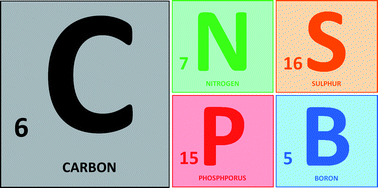Heteroatom doped carbon materials represent one of the most prominent families of materials that are used in energy related applications, such as fuel cells, batteries, hydrogen storage or supercapacitors. While doping carbons with nitrogen atoms has experienced great progress throughout the past decades and yielded promising material concepts, also other doping candidates have gained the researchers' interest in the last few years. Boron is already relatively widely studied, and as its electronic situation is contrary to the one of nitrogen, codoping carbons with both heteroatoms can probably create synergistic effects. Sulphur and phosphorus have just recently entered the world of carbon synthesis, but already the first studies published prove their potential, especially as electrocatalysts in the cathodic compartment of fuel cells. Due to their size and their electronegativity being lower than those of carbon, structural distortions and changes of the charge densities are induced in the carbon materials. This article is to give a state of the art update on the most recent developments concerning the advanced heteroatom doping of carbon that goes beyond nitrogen. Doped carbon materials and their applications in energy devices are discussed with respect to their boron-, sulphur- and phosphorus-doping.

You have access to this article
 Please wait while we load your content...
Something went wrong. Try again?
Please wait while we load your content...
Something went wrong. Try again?


 Please wait while we load your content...
Please wait while we load your content...